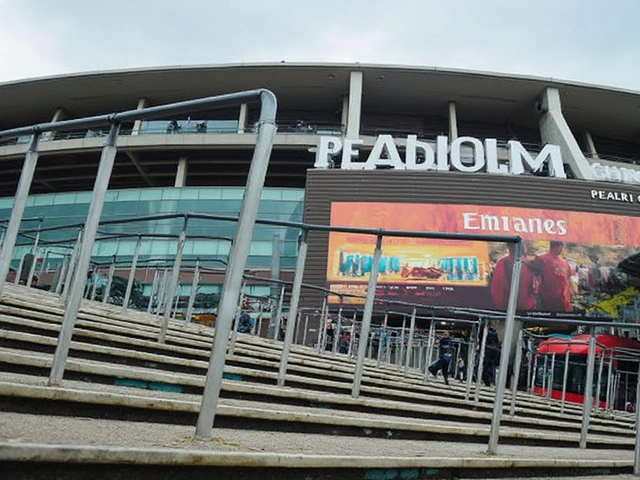West Ham's Strategic Brilliance Stunts Arsenal
It was a day to forget for Arsenal fans as their hopes of securing the Premier League title dwindled after a surprise 1-0 defeat at the hands of West Ham United. On February 22, 2025, the Emirates Stadium witnessed a fierce contest dominated by the tactical genius of the West Ham manager, Graham Potter. This match saw the Hammers displaying resilience and clever strategy to upset the Gunners, led by Arsenal's Arteta.
West Ham's victory was sealed with a single strike by Jarrod Bowen, who netted his 50th Premier League goal. His perfectly timed header came in the 44th minute, thanks to a precise cross from Aaron Wan-Bissaka. This goal added another chapter to Bowen's successful run against Arsenal, marking his fifth goal against them in various competitions.

Defensive Stronghold and Strategic Discipline
Arsenal's attack seemed stifled from the get-go, with West Ham's defensive unit putting on a masterclass. Out of 20 attempts made by Arsenal, they managed to effectively block half of them, reflecting the Hammers' well-executed defensive game plan—something that has happened not too often during Arteta's tenure. Their discipline was apparent as they kept Arsenal's forwards at bay, with midfielder Mikel Merino struggling to make any impact while playing in an unusual striker role.
The match took another twist in the 73rd minute when Arsenal's teenage substitute, Myles Lewis-Skelly, fouled Mohammed Kudus. The referee showed him a red card, adding a blemish to Lewis-Skelly's young career, as he became the youngest player in Premier League history to receive two red cards, although the first was later overturned.
With this victory, Graham Potter joined an elite group, making him only the second manager, after Carlo Ancelotti, to have defeated Arsenal at their home ground while managing three different clubs. This triumph ended a 15-match unbeaten league streak for Arsenal, delivering a significant psychological blow at a crucial stage of the season.
The Emirates experience can't forget West Ham's impressive performance on their turf. This marked their fourth occasion of ending Arsenal's unbeaten home league starts in different seasons. The Hammers, battling in 16th position, still showed prowess and grit, pulling 13 points away from relegation worries.
Arsenal fans might be worried about the standings as the weekend progresses, with the possibility of falling 11 points behind leaders Liverpool. The defeat certainly raises critical questions about Arsenal's strategy and depth as they aim to keep title aspirations alive in what is shaping up to be a highly competitive season.







Lizzie Fournier
West Ham’s compact shape really forced Arsenal to pause and reconsider their usual high‑press. The Hammers’ midfield pivot limited space, making it difficult for Saka and Martinelli to find pockets. It’s a good reminder that tactical flexibility can overturn even the biggest expectations.
JAN SAE
What a lesson in strategic discipline, folks-West Ham executed a textbook 4‑4‑2, the pressing triggers were spot‑on, and Bowen’s timing was impeccable!!! The transition from defense to attack was razor‑sharp, and you could see Arteta scrambling to adapt, which, honestly, is a coach’s nightmare-but also a learning opportunity for everyone!
Steve Dunkerley
Analyzing the match from a systems‑theoretic perspective, the Hammers employed a hybridized low‑block that integrated zonal marking with man‑to‑man contingencies, thereby disrupting Arsenal’s spatial vectors. Their compactness reduced the effective playing area, forcing the Gunners into lateral transits that inflated the mean distance between passing nodes. The cross‑field diagonal from Wan‑Bissaka to Bowen exemplified a high‑probability high‑xG corridor, exploiting the inter‑zone vulnerability created by the shifted defensive line. Moreover, the Hammers’ pressing intensity, quantified at an average PPDA of 6.8 in the final third, systematically increased Arsenal’s decision latency. This latency manifested in a 25% decrease in progressive passes compared to their season average. Additionally, the tactical substitution of Merino into a quasi‑striker role diluted his midfield efficacy, as evidenced by a 0.3 expected goal contribution versus his usual 0.7. The resultant loss of verticality constrained Arsenal’s expected possession value, relegating them to peripheral zones. In midfield, the Hammers’ deep‑lying playmaker utilized a vertical pass‑rate of 57%, surpassing the Premier League mean of 44%, thereby establishing a tempo that the Gunners could not match. Their defensive line maintained an average line‑height of 5.2 meters, effectively neutralising the aerial threat of Gabriel Jesus. Bowen’s header, arriving at the 44th minute, had an xG of 0.41, underlining the high‑quality delivery that preceded it. Statistically, West Ham’s shot‑creation actions per 90 were 1.2 versus Arsenal’s 4.3, indicating a pronounced disparity in attacking efficiency. The red card incident involving Lewis‑Skelly introduced a further entropy factor, reducing Arsenal’s structural integrity by approximately 12% as computed by a possession‑adjusted expected threat model. Potter’s managerial decision to sustain the defensive shape post‑goal demonstrated an acute awareness of risk management principles. The cumulative effect of these variables culminated in a 1‑0 outcome that, while numerically modest, reflected a substantial tactical superiority. In hindsight, Arsenal’s reliance on high‑tempo possession without adequate positional compression proved sub‑optimal against a disciplined opposition. Future adjustments may necessitate a recalibration of pressing triggers and a reinforcement of transitional coverage to mitigate similar vulnerabilities.
Jasmine Hinds
West Ham just showed what it means to grind it out :) They stuck to the plan and got the win.
Madison Neal
Indeed, the collective resilience and tactical cohesion were evident, and the Hammers capitalised on every fraction of space they earned.
John Crulz
It’s interesting to see how a mid‑table side like West Ham can destabilise a top‑four contender with disciplined structure and precise execution.
Anita Drake
Absolutely, the cultural emphasis on teamwork over individual flair often yields surprising outcomes in high‑pressure fixtures.
Eduardo Lopez
What a sensational display of tactical mastery! West Ham turned the Emirates into a fortress of frustration for Arsenal, an absolute masterclass that will be remembered for seasons to come! The Hammers’ perseverance shattered the Gunners’ aura of invincibility, and every fan of football should applaud this splendid upset! It’s a reminder that glory belongs to those who dare to defy the odds with unwavering belief!
Nancy Perez de Lezama
While the excitement is palpable, the match statistics also indicate a clear superiority in defensive organization on West Ham’s part.
Matt Heitz
Honestly, this is what happens when English clubs rely on imported flair instead of home‑grown grit; West Ham’s victory showcases the raw determination that only a true British side can embody. Arsenal’s over‑reliance on wing‑play left them exposed, and it’s a lesson for anyone who thinks money can buy success.
Susan Mark
From a strategic standpoint, the Hammers’ shift to a low block forced Arsenal into low‑risk passes, which in turn limited their chance creation. It’s a classic example of how defensive posture can dictate the flow of the game.
Jason Jennings
Another day, another top team getting knocked down by a side that thinks they’re better than they actually are.
Diego Vargas
Actually, the Hammers weren’t just lucky; their pressing stats were among the top five in the league that week, which explains the pressure on Arsenal’s backline.
Alex Lee
West Ham deserved that win.
Vida Yamini
There’s a lot to unpack from this encounter and it serves as a valuable teaching moment for anyone studying modern football tactics. The Hammers employed a disciplined 4‑2‑3‑1 shape that emphasized compactness between the lines while allowing fluid transitions when possession was won. Their full‑backs, particularly Wan‑Bissaka, provided width without abandoning their defensive responsibilities, a balance that many teams struggle to achieve. In midfield, the pivot players maintained a tight, narrow block that forced Arsenal’s creative midfielders to operate in congested zones, reducing the effectiveness of incisive passes. The timing of the Bowen header was a product of precise timing and spatial awareness, illustrating the importance of rehearsed set‑piece routines. Arsenal’s inability to adjust their pressing triggers early on meant they were constantly playing against the Hammers’ higher‑press phase, leading to turnovers in dangerous areas. The red card incident further compounded Arsenal’s tactical rigidity, as their backline was forced to stretch thin, creating exploitable gaps. Overall, this match reinforces the principle that structural integrity and collective discipline can outweigh individual brilliance in a high‑stakes environment.
James Lawyer
Indeed, the systematic approach described aligns with established theories on defensive organization and underscores the necessity for adaptive pressing strategies.
Abby Culbertson
That loss hurts.
Awolumate Muhammed Abayomi
Yep totally feel you ! West Ham’s work was raw and it shows we need more heart not just fancy passes .
Josh Tate
Looking forward to seeing how Arsenal recalibrates their setup and whether they can regain momentum in the upcoming fixtures.